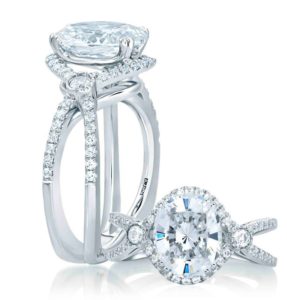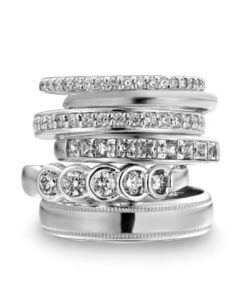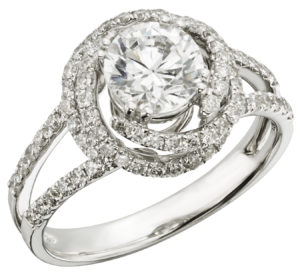Platinum Power
Platinum jewelry sales increased by 10% (in ounces) in the United States in 2015, according to the Platinum Guild International’s annual Retail Barometer report. This marked the third consecutive year platinum sales rose in the U.S. market, following an 8% increase in 2014 and 11% in 2013.
 The lower price of platinum compared to gold stimulated growth, said the report. The average price of platinum, at $1,053 per ounce, was 10% lower than that of gold, which was $1,160—closing the gap between gold and platinum jewelry at retail. The current price per ounce for platinum is $1,034, and gold is $1,327. PGI expects U.S. sales of platinum jewelry to grow between 5% and 7% in unit volume in 2016, and demand to rise more than that projected for jewelry overall.
The lower price of platinum compared to gold stimulated growth, said the report. The average price of platinum, at $1,053 per ounce, was 10% lower than that of gold, which was $1,160—closing the gap between gold and platinum jewelry at retail. The current price per ounce for platinum is $1,034, and gold is $1,327. PGI expects U.S. sales of platinum jewelry to grow between 5% and 7% in unit volume in 2016, and demand to rise more than that projected for jewelry overall.
Huw Daniel, PGI CEO said the price situation encouraged manufacturers and retailers to increase their platinum offerings, including greater visibility of platinum jewelry at major chain stores, where just a few years ago the metal was practically non-existent.
Platinum gives retailers a great opportunity to add value to their bottom line particularly in bridal ring sales, says PGI President Jenny Luker. More than three quarters of consumers desire platinum—it’s either their first choice or a serious consideration. And, selling a platinum engagement ring can result in significantly higher profits for retailers. With only 15% of consumers actually buying platinum, she says there’s huge opportunity for growth.
S amuel Sandberg president of A.Jaffe, New York says platinum has gained tremendous strength the last two years. He attributes the growth to greater media exposure on the red carpet and celebrity weddings, as well as increased advertising and marketing by PGI and brands like his own.
amuel Sandberg president of A.Jaffe, New York says platinum has gained tremendous strength the last two years. He attributes the growth to greater media exposure on the red carpet and celebrity weddings, as well as increased advertising and marketing by PGI and brands like his own.
Sadhna Venkat for MWI Eloquence, New York says her company has increased its platinum offerings and sales in bridal the last few years. “We do a lot of business with independents and platinum is a differentiating factor for them.”
Trends
In bridal, Luker continues to see strong sales for platinum engagement rings in two design categories—classic basics (solitaires, halos) and romantic pieces inspired by floral designs or nature motifs. “We’re also seeing more platinum bands selling. They could be stackable or single bands, from small, delicate plain platinum to larger, more intricate styles.”
Phyllis Bergman, CEO of Mercury Rings, a division of Interjewel Group, New York, is doing well with platinum bands for bridal and anniversary. “Bands are huge, and in platinum not just gold, both plain and set with diamonds.” She sees bands an enormous opportunity for the jewelry industry. “Bands are trending well with independents and majors. They’re multi generational and for many occasions.” She notes that petite bands that can be worn with engagement rings, separate, or stacked remain strong.
 Trending in fashion, Luker cites oversized, chunky platinum earrings and bracelets, sometimes one earring or one bangle worn. “We’re also seeing more combinations of materials—crystals, raw stones or color gems or leather mixed with platinum.”
Trending in fashion, Luker cites oversized, chunky platinum earrings and bracelets, sometimes one earring or one bangle worn. “We’re also seeing more combinations of materials—crystals, raw stones or color gems or leather mixed with platinum.”
Expected to be a game-changer for platinum manufacturing is 3D printing, says Luker, as shown at Baselworld this year through the collaboration of PGI, two U.K. designers, and Cooksongold, a Birmingham, United Kingdom based jewelry making supplier of precious metal. For its printing machine the Precious M080, Cooksongold created an advanced powdered metal stock 950Pt/Ru (platinum) that allows for rapid re-use, high yield and minimal scrap.
Marketing
Consumer research reveals that desire for platinum is high. Venkat says young consumers looking for tailored, elegant looks are gravitating to platinum. “They like the platinum story. Quality, strength and durability make platinum a great choice and value for consumers, and the incremental profits from platinum sales make it a very valuable product for retailers.”
Bergman, who has made videos with PGI and marketed through its press portal, hails video the most effective channel to market the metal, as millennials take in a lot of their information this way. In fact, on a national consumer level, PGI is promoting platinum online in digital advertising and social media. Luker encourages retailers and manufacturers to share platinum products, stories or facts socially and use #beplatinum, featured on the social feed of PGI’s newly launched website www.platinumjewelry.com.
 The biggest challenge in communicating value, says Luker, is the lack of commitment and/or education at point of sale. To help jewelers close sales, she says PGI launched an animated online sales training platform that provides information in a fun, fast way. PGI also helps jewelers at the bench with its Platinum Quality Assurance Benchmarks: a step-by-step guide to tackling the most common situations they’d encounter with platinum. Both programs are free to retailers at www.platinumlearning.com.
The biggest challenge in communicating value, says Luker, is the lack of commitment and/or education at point of sale. To help jewelers close sales, she says PGI launched an animated online sales training platform that provides information in a fun, fast way. PGI also helps jewelers at the bench with its Platinum Quality Assurance Benchmarks: a step-by-step guide to tackling the most common situations they’d encounter with platinum. Both programs are free to retailers at www.platinumlearning.com.







